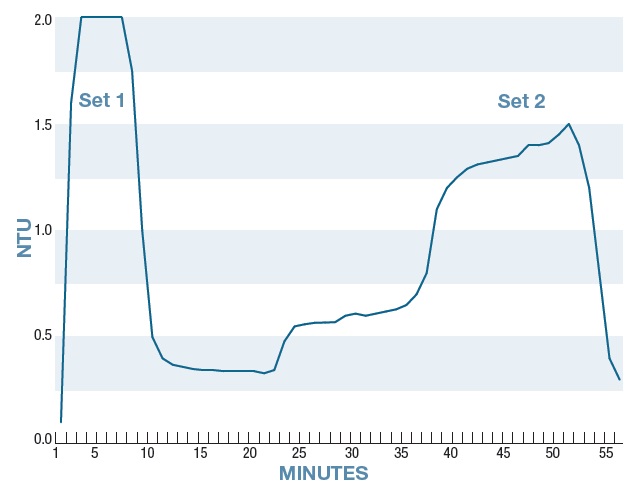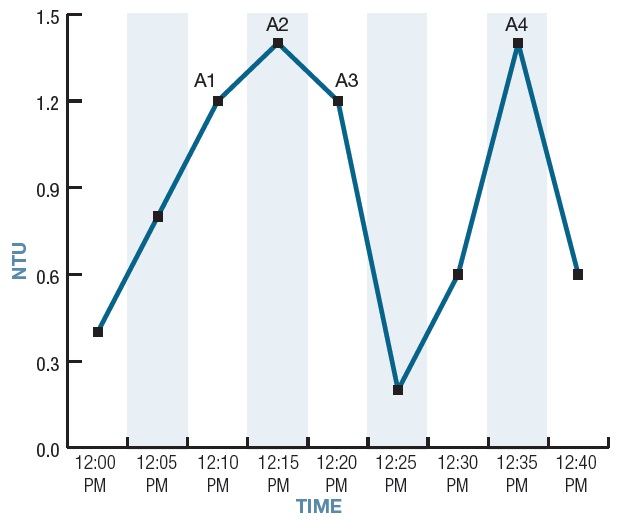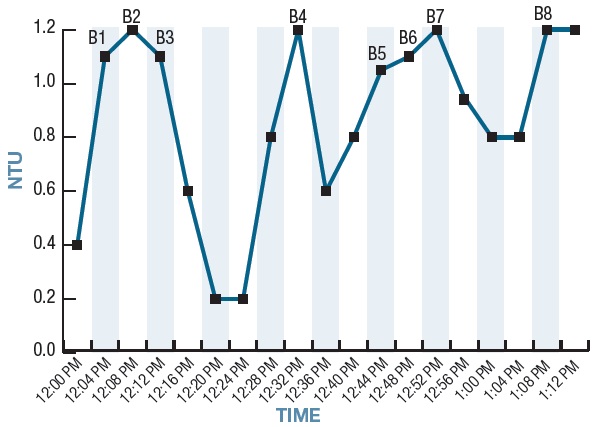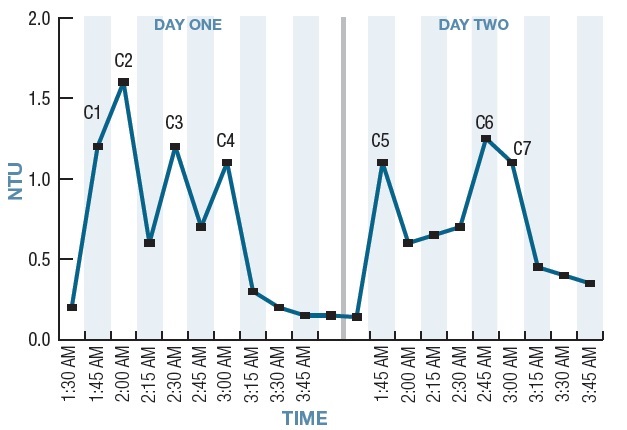Filtration processes technical bulletin
Information for owners and operators of municipal residential drinking water systems about filter monitoring, performance, and reporting requirements at drinking water systems subject to the Safe Drinking Water Act.
Background
This page provides general information on filtration performance. You should not rely on it for compliance purposes.
This information:
- may not be applicable to all drinking water systems
- does not provide relief from compliance with conditions or requirements in any licence, permit, approval or order issued by the ministry
Filtration
Filtration is a physical process which is used for the separation of solids from fluids by interposing a medium through which the fluid can pass, but the solids (or at least part of the solids) in the fluid are retained. It has to be emphasized that the separation is not complete, and it will depend on the pore size and the thickness of the medium as well as the mechanisms that occur during filtration.
Turbidity
Turbidity is a measurement used to assess the cloudiness of water caused by suspended particles such as clay, silt, finely divided organic and inorganic matter, plankton and other microscopic organisms. For the purpose of O. Reg. 170/03, turbidity must be measured in Nephelometric Turbidity Unit (NTU). It measures the amount of light scattered when it bounces off the suspended particles. In general, the cloudier the water, the more light scatters and the higher the measured turbidity. Since filtration is a unit process that separates solids from water, performance / effectiveness of a filter is assessed by the quality of the filtered water’s measured turbidity.
O. Reg. 170/03 regulatory requirements
If a drinking water system is required to provide filtration, depending on the category of the system and the type of filtration process used by the system, a grab sample from each filter’s effluent line must be taken and manually analyzed for turbidity at a specific frequency or, samples must be taken and analyzed for turbidity by continuous monitoring equipment serving each filter (Schedule 16, 16-3 (1.) 6).
When filter effluent turbidity is measured by continuous monitoring equipment, the equipment must have the capability of taking samples, testing and recording at a minimum frequency of 15 minutes. The equipment must record the date, time, sampling location and the test result. An alarm must sound when a test result exceeds 1.0 NTU (Schedule 6, 6-5 (1) 2 and (1.1) 1). If the continuous turbidity monitoring equipment is capable of testing more often than every 15 minutes (i.e. every 2 seconds) instead of recording all test results (i.e. 450 measurements) taken during each 15 minute interval, the equipment may be set to check and calculate “minimum”, “maximum” and “mean” values for that interval (from the 450 points). All 3 results will be recorded at the end of the 15 minute period. The equipment must also record the sampling location, date of the tests conducted and time at the end of the 15 minute period.
Regardless of the result recording protocol used (all results or the 15 minute interval maximum, minimum and mean values), an alarm must sound every time a test result exceeds 1.0 NTU and the equipment must record every such test result as well as its sampling location, date and the time of the test (Schedule 6, 6-5: (1) 2 and (1.1) 1).
Upon written request from the drinking water system owner, regulatory relief on specific sampling, testing, monitoring and/or reporting requirements (“other regulatory relief”) may be granted by the approving Director, if appropriate. On a case-by-case basis, the Director may impose conditions/special requirements in lieu of the requirements for which relief has been granted.
Turbidity adverse result reporting and corrective action
Schedule 16, 16-3 (1) of O. Reg. 170/03 defines an adverse test result for turbidity as:
If the drinking water system is required to provide filtration and a report under subsection 18(1) of the Act has not been made in respect of turbidity in the proceeding 24 hours, a result indicating that turbidity exceeds 1.0 Nephelometric Turbidity Units (NTU) in,
- a grab sample of water taken from a filter effluent line, or
- two samples of water from a filter effluent line that are tested by continuous monitoring equipment, if,
- two samples were taken 15 minutes or more apart and the later of the two samples was the first sample that was taken 15 minutes or more after the earlier sample, and
- the filter effluent line is directing water to the next stage of the treatment process
Grab sample
For systems where filtration is required and grab samples are allowed, any filter effluent grab sample test result that exceeds 1.0 NTU is an adverse test result with one exception - if no other adverse test result has been reported, for the purpose of section 18 of the Safe Drinking Water Act within 24 hours, prior to this test result.
The adverse result must be reported by the owner / operating authority to the Ministry’s Spill Action Centre (SAC), to the Medical Officer of Health (MOH) and, except for large municipal residential systems, to the operator of each designated facility served by the system (Schedule 16, 16-5 and 16-6 ).
Continuous samples
According to Schedule 6, 6-5 (1.1)1, a drinking water system owner must ensure that, if using continuous monitoring equipment for sampling and testing turbidity of a filter effluent, the equipment meets certain standards including causing an alarm to sound if a test is above the maximum alarm standard of 1.0 NTU. This is a regulatory alarm.
If two alarms (or two readings exceeding 1.0 NTU), 15 minutes interval or more (“more” referring to the first reading polled immediately after the 15 minutes of the first alarm or reading) apart, indicates that the filter turbidity has exceeded 1.0 NTU and the owner has not reported a turbidity exceedance in the 24 hours prior to this for the same filter and the filter effluent line is directing water to the next stage of the treatment process, then the turbidity exceedance is a prescribed adverse result for the purpose of section 18 of the Safe Drinking Water Act. The adverse result must be reported by the owner / operating authority to the Ministry’s Spill Action Centre (SAC), to the Medical Officer of Health (MOH) and, except for large municipal residential systems, to the operator of each designated facility served by the system (Schedule 16, 16-5 and 16-6).
The following examples are provided to illustrate various scenarios.
Example 1
Readings are taken at 1 min. intervals. Set 1 readings are above 1.0 NTU & occurred from T=2 to T=9 min. Maximum time between 2 results exceeding 1.0 NTU is 7 min. which is less than 15 min.; therefore, it is not a reportable event. In the case of Set 2 readings, the time between the first and last reading exceeding 1.0 NTU is greater then 15 minutes (T=38 to T=54); therefore it is a reportable event when T=53.

Example 2
Polling frequency: 5 min.
Time between A1 and A2: 5 min. <15 min.
Time between A1 and A3: 10 min. <15 min.
Time between A3 and A4: 15 min.
Therefore, A4 is an adverse result at 12:35 p.m. and the test must be reported as adverse under Schedule 16 16-3(1)6.

Example 3
Polling frequency: 4 min.
Time between B1 and B2: 4 min.
Time between B1 and B3: 8 min.
Time between B4 and B5:.12 min.; all less than 15 min.
Time between B4 and B6:16 min. >15 min.
B6 is the first reading taken 15 or more min. after B4. Therefore, B6 is an adverse result at 12:48 a.m. and must be reported under Schedule 16 16-3(1)6. Although the 2 readings, B7 and B8, are 16 min. apart, the reading B8 at 1:08 a.m. is not reportable as the previous report was made at 12:48 a.m., which is within 24 hours.

Example 4
A drinking water system takes a sample every 15 min. and records each turbidity test result as shown. The drinking water system sounds a regulatory alarm when it exceeds 1.0 NTU.
Time between C1 and C2 = 15 min. C2 is an adverse result on Day1 at 2:00 a.m. and therefore, must be reported as adverse under Schedule 16 16-3(1)6. C3, C4 and C5 are all >1.0 NTU; but no two readings taken 15 min. apart are above 1.0 NTU. Also, readings are within 24 hours of reporting result C2. Therefore, C3, C4 and C5 are not reportable results.

Time between C6 and C7 = 15 min.
Time between C2 and C7 > 24 hours
C7 is an adverse result on Day 2 at 3:00 a.m.. Therefore, it must be reported as an adverse result under Schedule 16 16-3(1)6.
Performance of filtration process
Pathogen removal credits are assigned to various treatment technologies in the ministry’s document, Procedure for disinfection of drinking water in Ontario, as follows:
| Treatment technology | Log removal credit - Giardia cysts | Log removal credit - viruses | Log removal credit - Cryptosporidium oocysts |
|---|---|---|---|
| Conventional filtration | 2.5 | 2 | 2 |
| Direct filtration | 2 | 1 | 2 |
| Slow sand filtration | 2 | 1 | 2 |
| Cartridge/bag filters | 2.0 + | 0 | 2 |
| Membrane filtration | 3.0 + | 0.0 to 2.0 + | 2 |
Conventional filtration is the most common treatment process currently used by drinking water system that rely on raw water supplies which are surface water. This treatment process consists of chemical coagulation, rapid mixing, flocculation and sedimentation followed by rapid sand filtration.
Performance criteria for a conventional filtration system
In order to be considered conventional filtration and claim the 2 log Cryptosporidium oocyst removal, 2.5 log Giardia cysts removal and 2 log virus removal credits, the filtration process must meet the following criteria:
- use a chemical coagulant at all times when the treatment plant is in operation
- monitor and adjust chemical dosages in response to variations in raw water quality
- maintain effective backwash procedures, including filter-to-waste or an equivalent procedure during filter ripening to ensure that the effluent turbidity requirements are met at all times
- continuously monitor filtrate turbidity from each filter
- meet the performance criterion for filtered water turbidity of less than or equal to 0.3 NTU in 95% of the measurements each month
To be able to assign filtration credits, all of the 5 criteria listed above must be met. The first 4 criteria are straight forward. Therefore, the details as to how to calculate the 95% are provided below.
95% performance calculation
The filtration process that is to receive a pathogen removal credit refers to the filters in operation and therefore, the 95% is calculated using the turbidity measurements taken in a calendar month from each filter that operated in the drinking water system during that month. In the calculation, use only the measurements taken when the filter effluent line is directing water to the next stage of the treatment process. Some drinking water systems may be taking turbidity measurements even when the filter is either in backwash mode or in filter-to waste-mode. These “off-line” measurements are not to be included in the calculations.
Example
Adams Peek drinking water system is a conventional filtration system. It has 4 filters and effluent from the 4 filters is continuously monitored by 4 turbidity meters, each installed on the effluent line of a filter. It is determined that filters No. 1, No. 2, No. 3 and No. 4 were either in “backwash” mode or in “filter-to waste” mode, for a total period of 10 hours, 8.5 hours, 9.25 hours and 9 hours, respectively, during the calendar month of June 2009. The Supervisory Control and Data Acquisition (SCADA) system does not record any turbidity reading during this period. What is the performance of the filtration process at the Adams Peek drinking water system for the month of June 2009?
Case I
The turbidity meters take a reading every 1 min. interval. The Supervisory Control and Data Acquisition (SCADA) system records all 1 min. testing data, including time, filter number and turbidity reading in NTU when the filtered water is discharged to the next treatment process. The SCADA system also alarms and records any reading that exceeds 1.0 NTU.
| Filter | Backwash/filter-towaste (hrs) (from records) | Number of turbidity measurements taken by turbidity meter | Number of turbidity measurements > 0.3 NTU (observed) | Number of turbidity measurements ≤ 0.3 NTU |
|---|---|---|---|---|
| No. 1 | 10 | 42,600 | 500 | 42,100 |
| No. 2 | 8.5 | 42,690 | 650 | 42,040 |
| No. 3 | 9.25 | 42,645 | 400 | 42,245 |
| No. 4 | 9 | 42,660 | 300 | 42,360 |
| All 4 filters | N/A | 170,595 | N/A | 168,745 |
Actual filtration period for filter No.1 = {[(30 days × 24) hr − 10 hr] × 60} min.
= 42,600 measurements (measurement every minute) Percentage of measurements less than or equal to 0.3 NTU= {168,745 ÷ 170,595 } × 100 = 98.916% > 95%
Case II
The turbidity meters take readings every 30 seconds. The SCADA system takes all 30 second test data within a period of 15 min., calculates and records maximum, minimum and mean readings in NTU, at the end of the 15 min. period along with time and filter number. The readings are recorded only when the filtered water from the particular filter was discharged to the next treatment process during that 15 min. period. All of these recorded values (the maximum, minimum and mean values for each 15 min. period) are used in the monthly 95% calculations. The SCADA system also alarms and separately records any reading that exceeds 1 NTU. These separately recorded readings are not included in the calculations as they are a subset of all recorded readings and have already been accounted for.
| Filter | Backwash/filter-towaste (hrs) (from records) | Number of turbidity measurements taken by turbidity meter | Number of turbidity measurements > 0.3 NTU (observed) | Number of turbidity measurements ≤ 0.3 NTU |
|---|---|---|---|---|
| No. 1 | 10 | 8,520 | 117 | 8,403 |
| No. 2 | 8.5 | 8,538 | 117 | 8,403 |
| No. 3 | 9.25 | 8,529 | 93 | 8,436 |
| No. 4 | 9 | 8,532 | 79 | 8,453 |
| All 4 filters | N/A | 8,532 | N/A | 8,453 |
Number of measurements for filter No.1 =
{[(30 days × 24) hr − 10 hr] × 4 times every hour × 3} = 8,520
Percentage of measurements less than or equal to 0.3
NTU= {33,690 ÷ 34,119 } × 100 = 98.74% > 95%
Note 1: In certain situations, a drinking water system owner may calculate the performance in percentage, for the filtration process on a daily basis. Then, calculate an average at the end of a calendar month. This calculation is also acceptable.
Note 2: In certain other situations, the SCADA system may record readings during backwash mode and filterto-waste mode. Since water is wasted and not sent to the next treatment process, readings taken during this period should not be taken into the calculations.
Note 3: For drinking water system using other technologies, use the respective performance criteria specified in the disinfection procedure (e.g. for membrane filtration, 0.1 NTU in 99% of the measurements).
Questions and answers
If the filtration process of a drinking water system does not meet the 95% criterion for a calendar month, should it be reported under Schedule 16, section 16-4?
Section 16-4 is intended to address reporting an observation other than an adverse test result prescribed by section 16-3 indicating that a drinking water system that provides or is required to provide disinfection is directing water to system users that has not been disinfected in accordance with the Ministry’s “Procedure for Disinfection of Drinking Water in Ontario.” The 95% is one of the criteria required to be met to receive removal credits for a filtration process. If it is observed (by conducting the calculations for the month) that this criterion is not met, the filtration process can not claim the assigned pathogen removal credits for the calendar month.
However, the filtration process represents only one of the possible barriers in a drinking water treatment system and there may be other down stream treatment processes (such as primary chlorination, ultraviolet (UV) etc.) that may have compensated for the pathogen removal credits lost by the filtration process (by not meeting the 95% criterion) during the calendar month. Therefore, the operator must check the other barriers and assess their removal/inactivation credits and ensure that the drinking water system has met the overall treatment requirements. Once it is determined that the overall pathogen removal/ inactivation requirements have not been met by the drinking water system for the calendar month, this must be reported immediately.
When exactly should the report be made?
Test results from a continuous monitoring equipment must be examined within 72 hours after the tests are completed (Schedule 6, subsection 6-5 (1) 3). Therefore, calculations for the performance of the filtration process using data from all continuous monitoring turbidity meters must be made within 72 hours after the end of each calendar month. If the calculation result for a particular month does not meet the 95% criterion and the down stream treatment processes have not compensated for the pathogen removal credits lost by the filtration process, the operator shall make a report to the Ministry, the medical officer of health and the owner of the drinking water system, immediately after the calculation and assessment is conducted.
What action must be taken if the filtration process of a drinking water system does not meet the necessary 95% performance criterion?
Once a report for water that has not been properly disinfected in terms of performance of filtration process has been made, the drinking water system owner and operating authority shall check and immediately restore proper disinfection (including proper filtration, which enables proper disinfection as well as contributes to the overall pathogen removal/inactivation) and take such other steps directed by the medical officer of health (Schedule 17, 17-2).
If the drinking water system has not met the overall pathogen removal/inactivation requirements, the owner and operator must check the operation of each filter for the preceding month, rationalise the cause for not meeting the filtration process performance and rectify the operation during the subsequent month.
For more information
If you have questions or would like more information about drinking water:
- email the ministry’s Environmental Assessment and Permissions Division at mdwlp@ontario.ca
- visit ontario.ca/drinkingwater
Footnotes
- footnote[1] Back to paragraph Number of all maximum, minimum and mean; 3 measurements for each 15 min. interval.